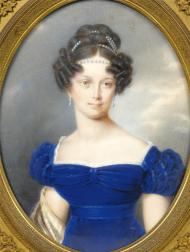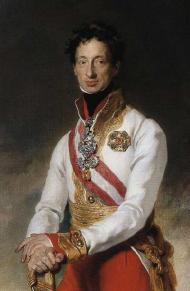Qui a épousé Henriette de Nassau-Weilbourg (1797-1829)?
Charles-Louis d'Autriche-Teschen a épousé Henriette de Nassau-Weilbourg (1797-1829) le . Princess Henrietta of Nassau-Weilburg avait 17 ans le jour du mariage (17 ans, 10 mois et 16 jours). Charles-Louis d'Autriche-Teschen avait 44 ans le jour du mariage (44 ans, 0 mois et 10 jours). L'écart d'âge était de 26 ans, 1 mois et 25 jours.
Henriette de Nassau-Weilbourg (1797-1829)

Henriette Alexandrine Frédérique Wilhelmine de Nassau-Weilbourg (Bayreuth - Vienne ) est une princesse allemande de l'ère post-napoléonienne qui devient par mariage l'épouse du héros d'Aspern, l'archiduc Charles-Louis d'Autriche-Teschen, et reste à ce jour la seule personnalité protestante inhumée dans la Crypte des Capucins, nécropole impériale des Maisons de Habsbourg et de Habsbourg-Lorraine.
Lire la suite...
Charles-Louis d'Autriche-Teschen

Archduke Charles Louis John Joseph Lawrence of Austria, Duke of Teschen (German: Erzherzog Karl Ludwig Johann Josef Lorenz von Österreich, Herzog von Teschen; 5 September 1771 – 30 April 1847) was an Austrian field marshal, the third son of Emperor Leopold II and Maria Luisa of Spain. He was also the younger brother of Francis II, Holy Roman Emperor. He was epileptic, but achieved respect both as a commander and as a reformer of the Austrian Army. He was considered one of Napoleon's most formidable opponents and one of the greatest generals of the French Revolutionary and Napoleonic Wars. Charles wrote several military works as well.
He began his career fighting the revolutionary armies of France. Early in the wars of the First Coalition, he saw victory at Neerwinden in 1793, before being defeated at Wattignies in 1793 and Fleurus in 1794. In 1796, as chief of all Austrian forces on the Rhine, Charles defeated Jean-Baptiste Jourdan at Amberg, Würzburg and Limburg, and then won victories at Wetzlar, Emmendingen and Schliengen that forced Jean Victor Marie Moreau to withdraw across the Rhine. He also defeated opponents at Ostrach, Stockach, Zürich and Mannheim in 1799. He reformed Austria's armies to adopt the nation-at-arms principle. In 1809, he entered the War of the Fifth Coalition and inflicted Napoleon's first major setback at Aspern-Essling, before suffering a defeat at the bloody Battle of Wagram. After Wagram, Charles saw no more significant action in the Napoleonic Wars.
As a military strategist, Charles was able to successfully execute complex and risky manoeuvres of troops. However, his contemporary Carl von Clausewitz criticised his rigidity and adherence to "geographic" strategy. Many Austrians nevertheless remember Charles as a hero of the French Revolutionary and Napoleonic Wars.
Lire la suite...